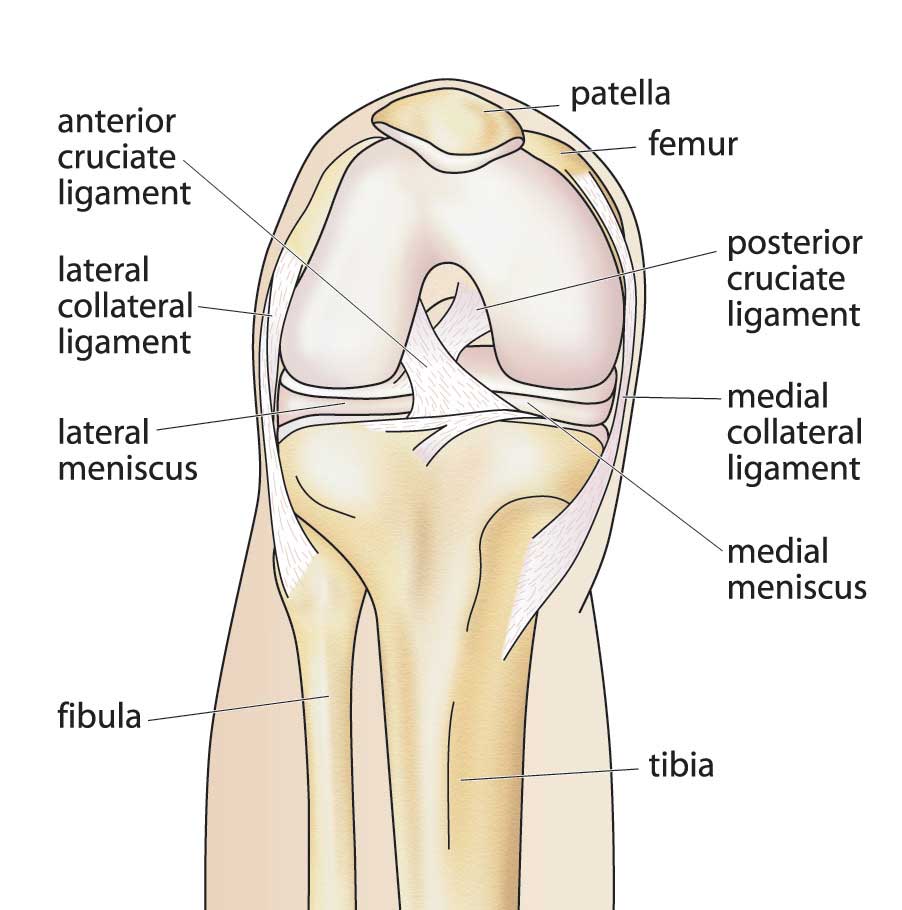
Understanding your knee
The normal knee
The knee joint is the largest and most complex joint in the body. It has four parts.
- The first two parts are knuckle-like projections at the lower end of the thigh bone and the upper end of the shin bone. These areas glide against each other and allow you to bend your knee.
- The third part, cartilage, covers all joint surfaces and is a smooth padding that allows the first two parts to touch and move together.
- The fourth part, the kneecap (patella), covers the knee joint. It is what you feel when you touch your knee.

The normal knee has four parts: two knuckle-like projections, cartilage and the kneecap (patella). © Allina Health System
The problem knee
Disease, injury or infection can affect the way the knee works. However, arthritis is the most common cause of knee joint deterioration. Arthritis is a name used to describe a number of diseases that cause swelling of the joints and friction on the cartilage and bones.
In the problem knee, the worn cartilage no longer serves as a cushion. When cartilage becomes damaged by an injury or by disease, the knee joint cannot move smoothly. As the cartilage wears away from the bones, the bones rub together and become irregular, creating a rough surface.
As the pain worsens, you will try not to use the joint as much. This causes the muscles to weaken and the joint to feel unstable and less able to support your body weight. An X-ray can determine the extent of joint damage. A knee joint replacement is an option to relieve the pain and instability.

Cysts, bone spurs and loss of cartilage can lead to knee problems. © Allina Health System
The knee after a knee replacement
The knee replacement surgery removes damaged bone and cartilage from the knee joint and replaces both the bone and cartilage with an artificial joint (prosthesis).
The artificial knee provides a smooth surface for your bones to touch and move together.
The upper part of the artificial knee is metal (titanium, tantalum or cobalt) and fits into your thigh bone. The lower part is metal and plastic (wear-resistant polyethylene) and fits into your shin bone. If the underside of your knee cap is damaged, a round plastic piece will be cemented onto it.
The three parts touch and glide against each other just as a normal knee joint does, allowing your knee to bend.
There are different approaches for knee replacement surgery, which change as the technology changes. Your surgeon will determine which approach will work best for you, based on your:
- age
- weight
- bone health
- overall health
- activity level
- specific knee degeneration or injury

An X-ray shows the artificial joint (prosthesis) after a knee replacement.
The knee after a partial (unicompartmental) knee replacement
Partial (unicompartmental) knee replacement surgery is done when only part of the knee is damaged. During this surgery the damaged articular cartilage is removed only from the damaged section of the knee, saving the ligaments and healthy bone within the knee.
The surgeon replaces the damaged section with a smooth metal and plastic surface that lets your knee move without pain. The partial replacement saves the ligaments within the knee so it moves like a normal knee.

An X-ray shows the artificial joint (prosthesis) after a partial knee replacement.
Visit allinahealth.org/kneereplacementvideo to watch a video with more information about your knee.